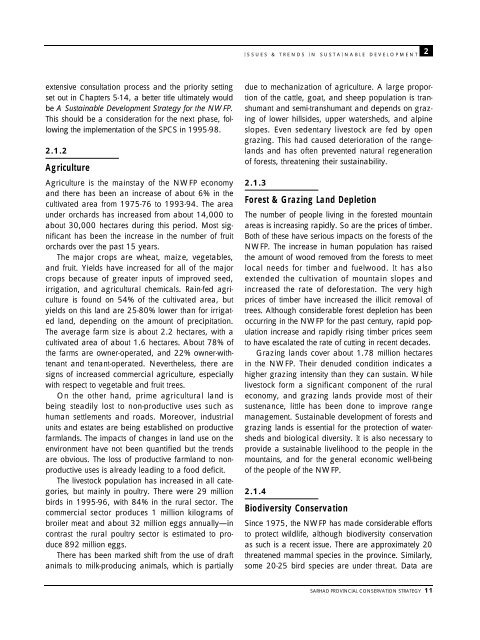Sarhad Provincial Conservation Strategy - IUCN
Sarhad Provincial Conservation Strategy - IUCN
Sarhad Provincial Conservation Strategy - IUCN
Create successful ePaper yourself
Turn your PDF publications into a flip-book with our unique Google optimized e-Paper software.
extensive consultation process and the priority setting<br />
set out in Chapters 5-14, a better title ultimately would<br />
be A Sustainable Development <strong>Strategy</strong> for the NWFP.<br />
This should be a consideration for the next phase, following<br />
the implementation of the SPCS in 1995-98.<br />
2.1.2<br />
Agriculture<br />
Agriculture is the mainstay of the NWFP economy<br />
and there has been an increase of about 6% in the<br />
cultivated area from 1975-76 to 1993-94. The area<br />
under orchards has increased from about 14,000 to<br />
about 30,000 hectares during this period. Most significant<br />
has been the increase in the number of fruit<br />
orchards over the past 15 years.<br />
The major crops are wheat, maize, vegetables,<br />
and fruit. Yields have increased for all of the major<br />
crops because of greater inputs of improved seed,<br />
irrigation, and agricultural chemicals. Rain-fed agriculture<br />
is found on 54% of the cultivated area, but<br />
yields on this land are 25-80% lower than for irrigated<br />
land, depending on the amount of precipitation.<br />
The average farm size is about 2.2 hectares, with a<br />
cultivated area of about 1.6 hectares. About 78% of<br />
the farms are owner-operated, and 22% owner-withtenant<br />
and tenant-operated. Nevertheless, there are<br />
signs of increased commercial agriculture, especially<br />
with respect to vegetable and fruit trees.<br />
On the other hand, prime agricultural land is<br />
being steadily lost to non-productive uses such as<br />
human settlements and roads. Moreover, industrial<br />
units and estates are being established on productive<br />
farmlands. The impacts of changes in land use on the<br />
environment have not been quantified but the trends<br />
are obvious. The loss of productive farmland to nonproductive<br />
uses is already leading to a food deficit.<br />
The livestock population has increased in all categories,<br />
but mainly in poultry. There were 29 million<br />
birds in 1995-96, with 84% in the rural sector. The<br />
commercial sector produces 1 million kilograms of<br />
broiler meat and about 32 million eggs annually—in<br />
contrast the rural poultry sector is estimated to produce<br />
892 million eggs.<br />
There has been marked shift from the use of draft<br />
animals to milk-producing animals, which is partially<br />
I S S U E S & T R E N D S I N S U S T A I N A B L E D E V E L O P M E N T 2<br />
due to mechanization of agriculture. A large proportion<br />
of the cattle, goat, and sheep population is transhumant<br />
and semi-transhumant and depends on grazing<br />
of lower hillsides, upper watersheds, and alpine<br />
slopes. Even sedentary livestock are fed by open<br />
grazing. This had caused deterioration of the rangelands<br />
and has often prevented natural regeneration<br />
of forests, threatening their sustainability.<br />
2.1.3<br />
Forest & Grazing Land Depletion<br />
The number of people living in the forested mountain<br />
areas is increasing rapidly. So are the prices of timber.<br />
Both of these have serious impacts on the forests of the<br />
NWFP. The increase in human population has raised<br />
the amount of wood removed from the forests to meet<br />
local needs for timber and fuelwood. It has also<br />
extended the cultivation of mountain slopes and<br />
increased the rate of deforestation. The very high<br />
prices of timber have increased the illicit removal of<br />
trees. Although considerable forest depletion has been<br />
occurring in the NWFP for the past century, rapid population<br />
increase and rapidly rising timber prices seem<br />
to have escalated the rate of cutting in recent decades.<br />
Grazing lands cover about 1.78 million hectares<br />
in the NWFP. Their denuded condition indicates a<br />
higher grazing intensity than they can sustain. While<br />
livestock form a significant component of the rural<br />
economy, and grazing lands provide most of their<br />
sustenance, little has been done to improve range<br />
management. Sustainable development of forests and<br />
grazing lands is essential for the protection of watersheds<br />
and biological diversity. It is also necessary to<br />
provide a sustainable livelihood to the people in the<br />
mountains, and for the general economic well-being<br />
of the people of the NWFP.<br />
2.1.4<br />
Biodiversity <strong>Conservation</strong><br />
Since 1975, the NWFP has made considerable efforts<br />
to protect wildlife, although biodiversity conservation<br />
as such is a recent issue. There are approximately 20<br />
threatened mammal species in the province. Similarly,<br />
some 20-25 bird species are under threat. Data are<br />
SARHAD PROVINCIAL CONSERVATION STRATEGY 11

















